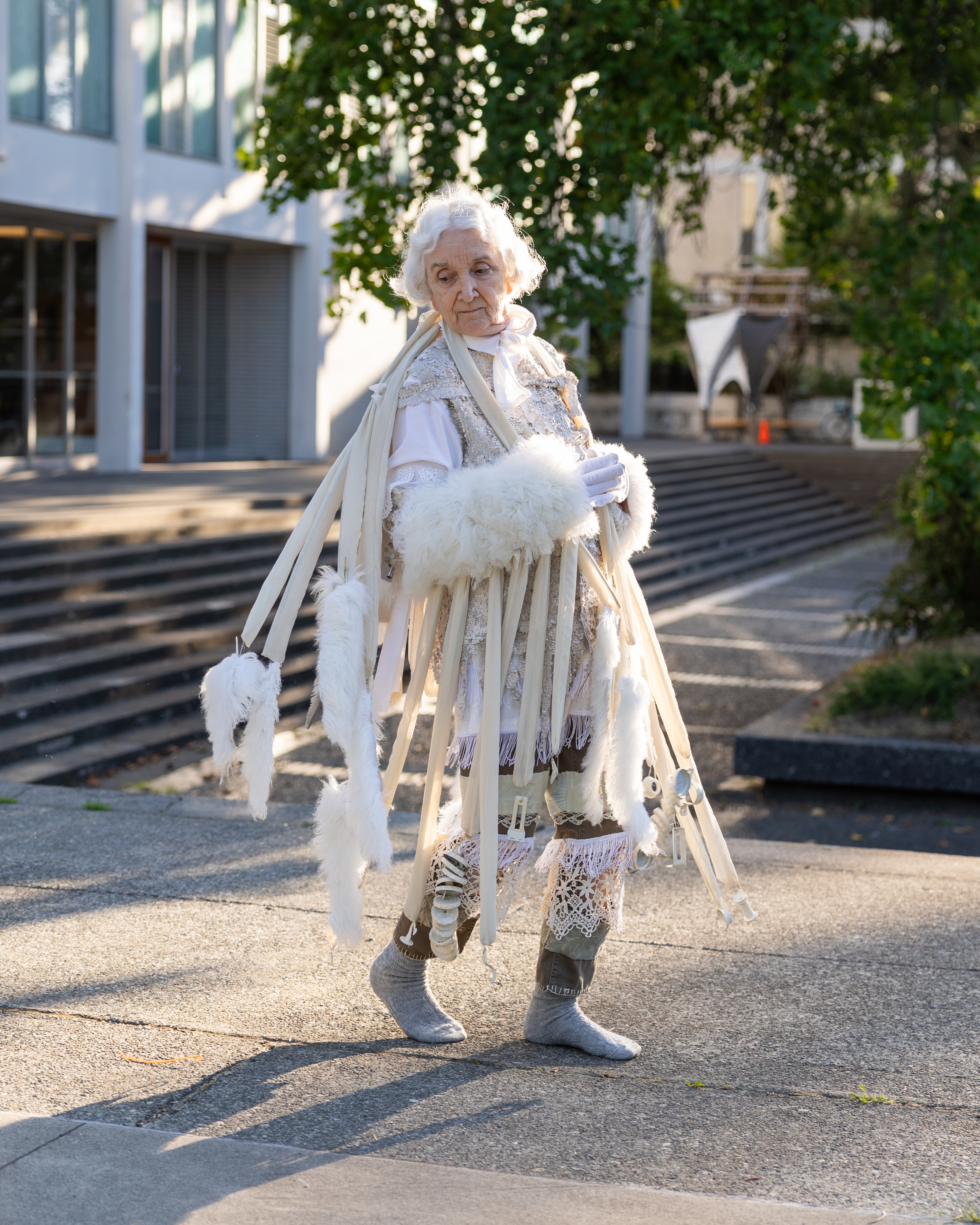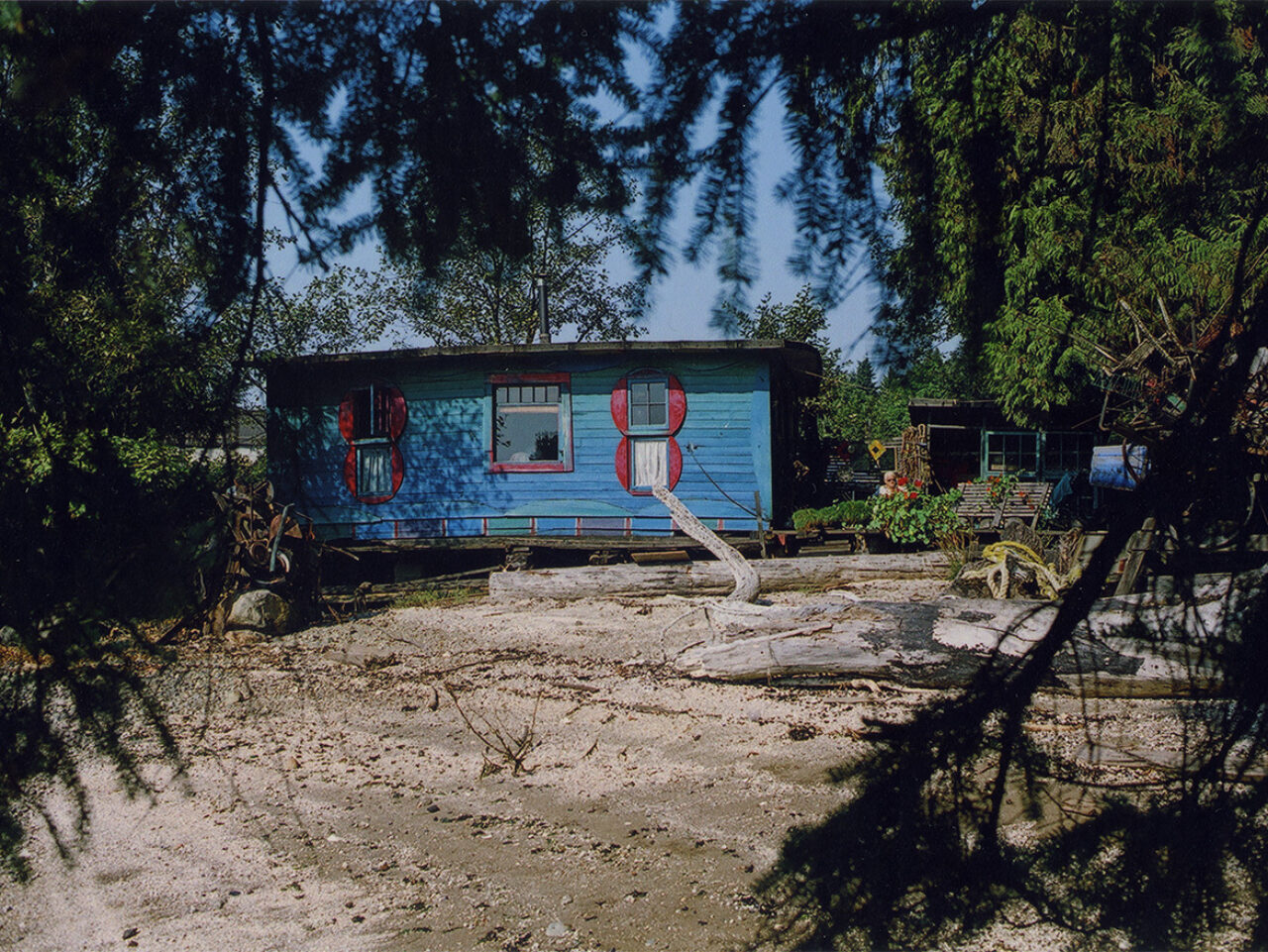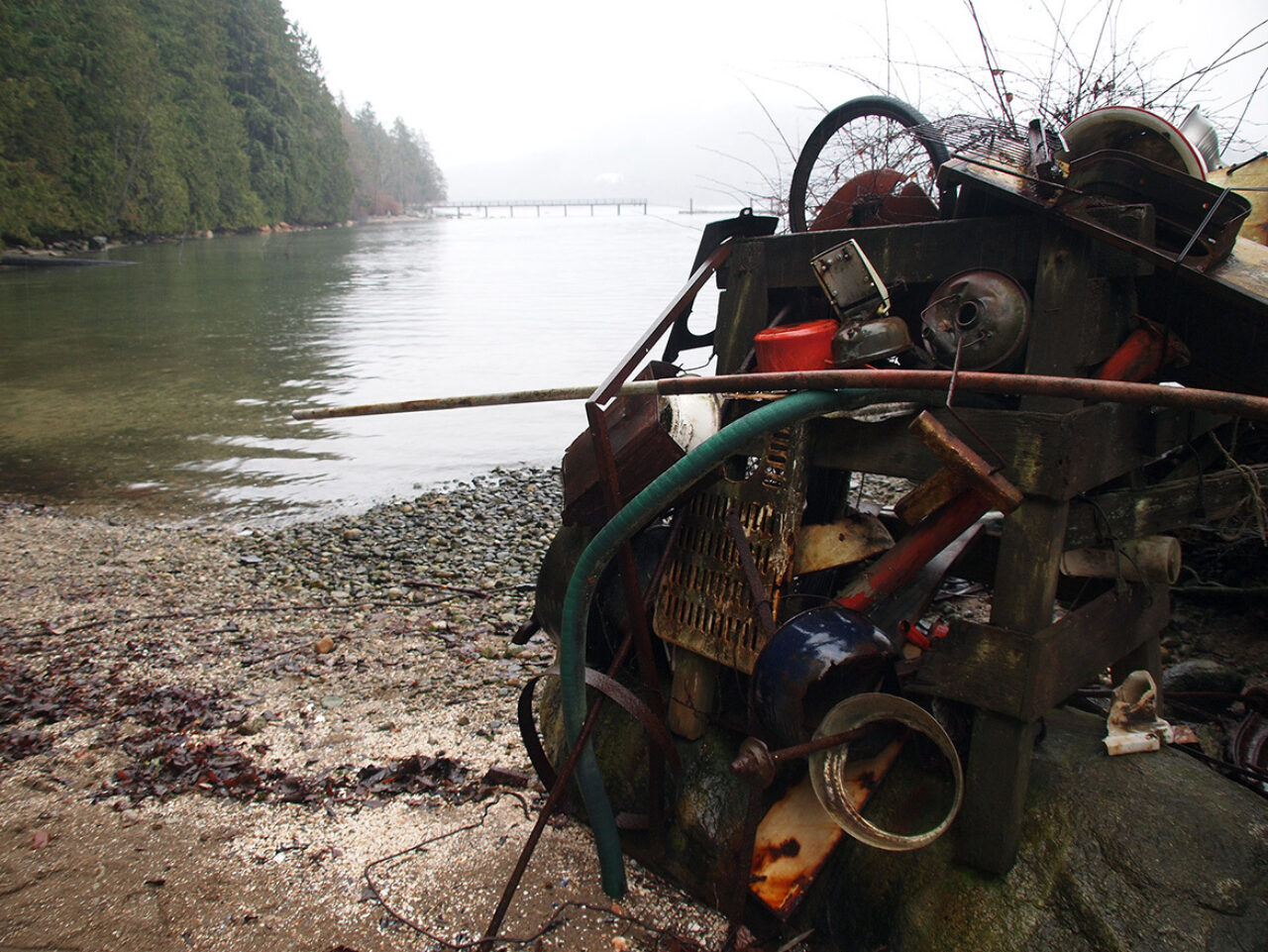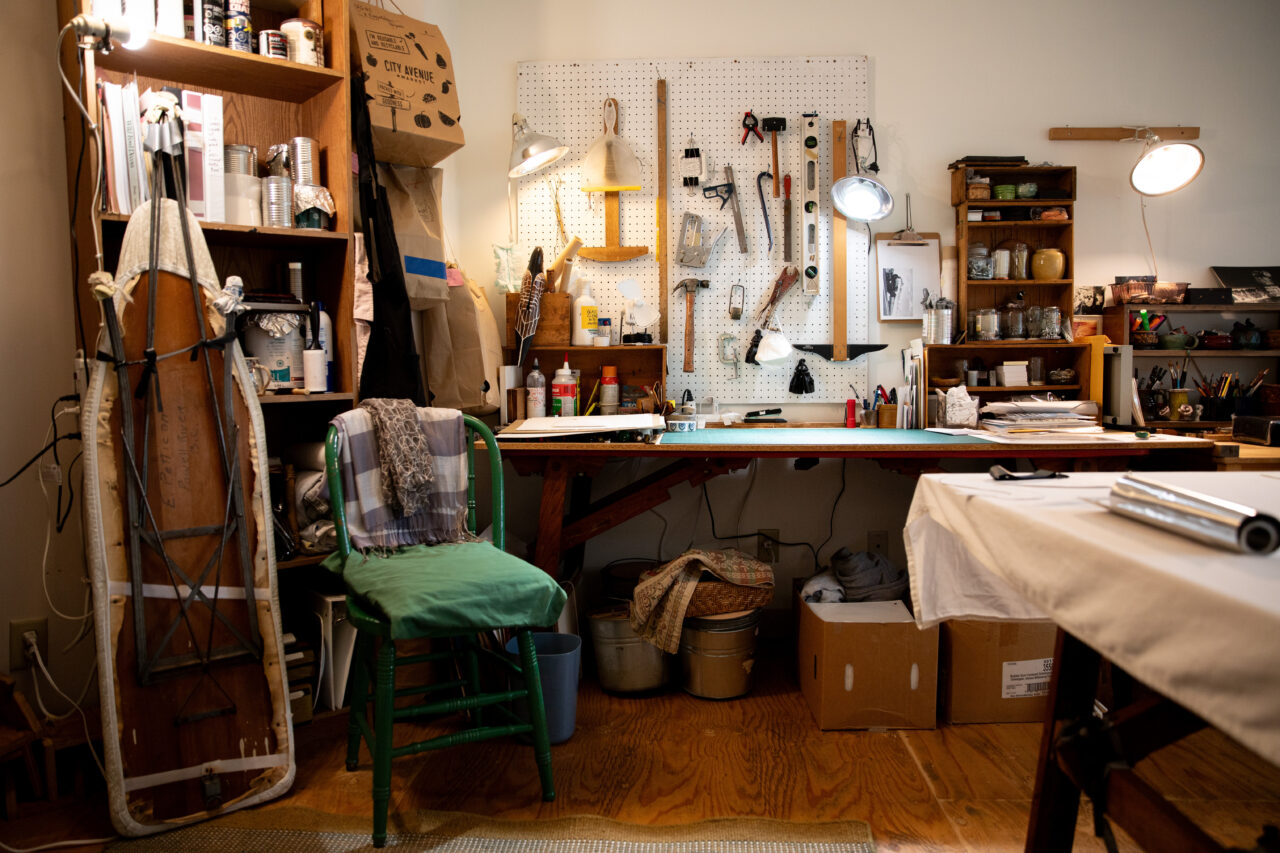Carole Itter in Joy and Despair

Carole Itter at the opening for her 2023 solo exhibition, Only when I’m hauling water do I wonder if I’m getting any stronger, at the Helen and Morris Belkin Art Gallery. (Photo by NK Photo / courtesy Helen and Morris Belkin Art Gallery)
Posted on
The award-winning, multidisciplinary artist and 2024 Emily Carr University Honorary Degree recipient discusses art, activism and the gifts that might be found in a commitment to a better future.
It’s March in Vancouver and the early spring sun is tumbling through the windows of Carole Itter’s modest basement apartment on the border between Strathcona and Chinatown.
“My courtyard out there is quiet,” she says gesturing to a walled outdoor space humming in the skittery light. “It’s one of the quietest places I’ve ever sat in. When we were out in the cabin, we were next to a shipyard. You can imagine the noise. There were days when they were sandblasting and we’d evacuate. We couldn’t take it any longer. I’d be looking at Al and see his lips move, but I wouldn’t know what he was saying.”
Carole, an award-winning, multidisciplinary artist, refers to The Blue Cabin, a legendary retreat and former float home installed on pilings in the intertidal zone at Cates Park in North Vancouver. Artist Al Neil, who would become Carole’s longtime partner, moved into the cabin in 1966, with Carole joining him in the late 1970s.
Carole created many of her seminal works at The Blue Cabin, including her first “rattle,” a kind of hanging sculptural assemblage made from detritus and castoffs collected from alleyways, beaches, basements and thrift shops.
In a recent exhibition text, the Helen and Morris Belkin Art Gallery writes that the works “signal the connection between deforestation, production, consumerism and disposal while offering a performative invitation to an imagined sonic and physical interaction.”

Carole Itter, Dollarton Cabin, 2015, depicts the legendary Blue Cabin where she and Al Neil, her longtime partner and a fellow artist, lived for many years.
Carole herself is breezier about the series, steering the conversation toward their material facture.
“I was collecting stuff that was on its way to the garbage, and I think it came to me pretty easily,” she recalls, noting the first rattle was “made outdoors on Al’s deck [at The Blue Cabin]. I didn’t have a studio then, and he let me work out there. I was very influenced by him at the time. And it was the beginning of a 40-year love story as well. All good stuff.”
While she remains an active practitioner, Carole’s home is hung with dozens of artworks from decades past — both her own and those of her late husband, Al, who passed away in 2017. A photo by Stan Douglas of The Blue Cabin’s interior hangs behind her throughout our conversation.
“I sometimes feel that I’m too reminiscent of all the things that have happened in the past,” she says. “And I think, am I at this stage of my life? Well, yes I am.”
But it’s those decades of practice — and her ongoing commitment to artmaking — that have consistently earned her attention from galleries, institutions and the public. Her record of solo exhibitions includes shows at the Vancouver Art Gallery, grunt gallery, Western Front and Or Gallery. Her work is included in the collections of the Canada Council Art Bank, the Vancouver Public Library, the Vancouver Art Gallery, SFU Galleries, Morris and Helen Belkin Art Gallery, Surrey Art Gallery and Nanaimo Art Gallery. She is the recipient of a VIVA Award and an Audain Prize for Lifetime Achievement in the Arts. And as of 2024, she is the recipient of an honorary degree from Emily Carr University.

Carole Itter, Grey Rattle, 1994. Collection of the Surrey Art Gallery. (Photo by Rachel Topham / Courtesy Morris and Helen Belkin Art Gallery)
Carole is also an ECU alum and former faculty member, having taught at the school for 17 years. Carole’s husband Al, meanwhile, was also honoured with an honorary degree from ECU in 2003.
Nevertheless, Carole confesses a measure of disbelief at finding herself in her current circumstance.
“This isn’t false modesty; I think I’m being as truthful as possible when I say, I don’t know how I got here,” she says. “I still think it’s an error that I’ve been given this honour.”
But talk to anyone who knows her work, and they’ll draw a direct line from her oeuvre to the themes and concerns that animate the practices of many of today’s most prominent artists.
“The artist’s focus on the local was part of a shared sensibility in Vancouver and beyond in the 1960s and has found renewed urgency and wisdom in the context of the climate crisis,” writes Belkin Gallery director Melanie O’Brian. “Itter’s hand-hewn work reasserts the presence of the body through ecological, feminist and anti-capitalist lenses, and offers insight into how humans see themselves in relation to each other and other beings in the world.”
Carole’s sensitive, sometimes humorous engagement with our material legacy — trash, single-use objects and substances left over from industrial production processes — banishes the apparition of permanency that haunts humanity’s grandest aspirations. Her occupation of spaces on the margins of our notice — especially those zones where human development gives way to untamed forces — is undertaken with a sense of gentle responsibility that offers a poetic paradigm for new ways of being in the world.

Carole Itter and Al Neil, Assemblage. (Photo by Esther Rausenberg, 2015)
For Carole, these concerns came almost instinctively. For instance, her performance work, Tarpaulin Pull, derived from years spent puzzling over a series of disintegrating tarps she and Al used in the wintertime to cover the woodpile at The Blue Cabin. She knew the material would need to be disposed of, but felt she “really needed to do something with it.”
She hauled the stuff to the beach at low tide, spread the pieces out and began weaving them together with blue plastic garden twine purchased in Chinatown.
“As the tide came in, I’d roll up the different sections above the high-tide mark, and the next day I’d roll them out and start again,” she says. “In a sense, I was trying to resuscitate it.”
As the work took shape, she called on artist and filmmaker Krista Lomax to record it on video. Once Carole was finished sewing, she tied the quilted tarps to her and Al’s rowboat and pulled them up the inlet to a dumpster with Krista capturing the gesture on film.
Carole is characteristically enigmatic about what might be called a ritualization of labour. She says she asked few questions about her impulse to make the work.
“There was a point where I thought I was simply cleaning up the mess behind our wood pile,” she says. “Then I’m resuscitating things and seeing a possibility of art happening. Then I’m throwing it all away too. I am not one to analyze too far toward the reason behind what I am physically doing.”
She adds that the work might have disappeared without a trace if Krista had not been there.
“It was a good high tide. The light was good. We couldn’t have asked for better. Not a soul around to see it except a dog that barked three times in the middle of the rowing event. We looked at it after and we thought, perfect, perfect, perfect. We’ll use that sound,” she says. “Krista turned it into a beautiful film. She really did. But if the film hadn’t worked, there’d be no story to tell.”

From Carole Itter's Tarpaulin Pull, 2006 (47.2-5.04, still 1). (Image courtesy Helen and Morris Belkin Art Gallery)
She suggests her “fascination bordering on obsession” with the latent potential of found materials is felt by many fellow practitioners.
“An awful lot of artists see it,” she says of the communicative magic of found objects. “I think for many of us, it’s a duty to gather these things up. We live in such a wasteful society.”
Turning to the subject of waste, Carole begins to reflect on the broader movements of history that preoccupied her practice and those of so many of her peers. Gender disparity, the civil rights movement, the Cold War and nuclear armament, the bombing of Nagasaki and Hiroshima, the exponential pace of industrialization, as well as subtler devastations such as the advent of plastics which began littering the landscape with forever materials — all of these defined the ways a generation of artists responded to the world.
“Each decade has these impacts that are overwhelming and are all felt personally as well,” she says, noting I had previously asked her about whether despair had ever played a part in her practice.
“I thought, ‘Despair is my middle name. I wallow in despair. I throw parties for myself with the theme of despair,’” Carole continues. “I think I’ve spent a large part of my life terrified as well as looking for joy. I’m laughing now, but I’m also crying. These are hard times, and there are so many things that have never been resolved.”
This irresolution to society’s most urgent problems gives Carole pause. But she points to groups such as Guerrilla Girls and Pussy Riot, both of which she acknowledges for their ability to pair direct action with aesthetics.
“These two major groups of women certainly knew how to feed the media, that hungry dragon,” Carole says. “I myself have never been a really bonafide activist in any sense, and I’m full of admiration for those who can do that kind of stuff.”

Carole Itter's studio in her home in East Vancouver in March, 2024. (Photo by Perrin Grauer)
She adds that artists are uniquely capable of providing opportunities to question what we take for granted. “Artists, I hope, are out on some radical edge, always. It’s absolutely necessary to be pushing at the edges of the status quo.”
Despite the despair she sometimes feels, Carole says activists and artists have been part of — and remain capable of — creating real, meaningful change. The words “ecology” and “environmentalism” weren’t uttered once while she was in elementary school in the 1940s, she notes.
“They weren’t part of the canon. They weren’t part of the vocabulary. So much has changed since then, and it’s so necessary,” she says.
Younger people, in particular, give Carole hope. This was the case during her years as an educator and remains the case now. Learning about their visions for a better future rarely fails to restore Carole’s faith in humanity.
“I meet young people now who blow my mind. Listening to them talk gives me a very big lift, knowing a younger generation is so committed to keeping this place going,” she says. “That’s their gift to the rest of us.”